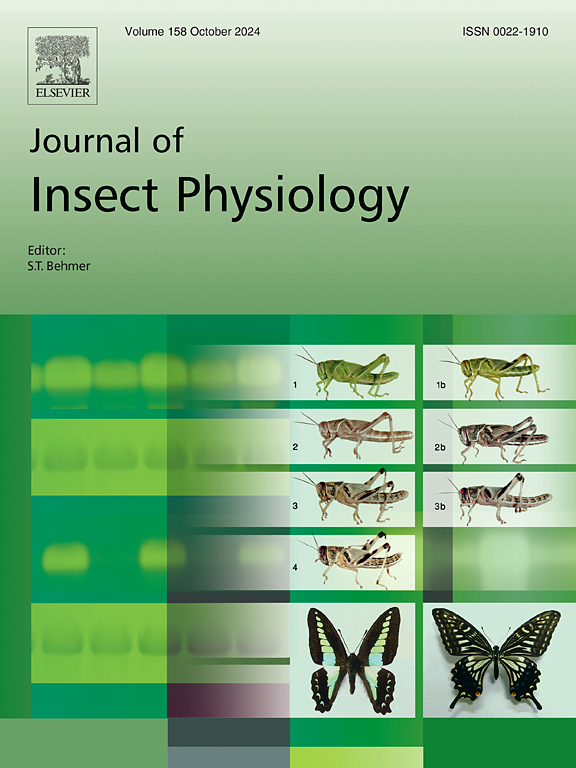Visually-guided defensive behaviors in triatomines (Heteroptera: Reduviidae)
IF 2.3
2区 农林科学
Q1 ENTOMOLOGY
引用次数: 0
Abstract
Reduviidae is a family of insects mainly composed of predatory species known as assassin bugs and obligate blood-feeding species known as kissing bugs. Although both groups possess relatively well-developed compound eyes, image vision has only been associated with feeding behaviors in assassin bugs. Here, we studied whether vision plays a role in supporting defensive behaviors in kissing bugs.
Our findings reveal that Rhodnius prolixus consistently responds to visual looming stimuli by either freezing or escaping and that it can rapidly switch between these behaviors based on the ongoing stimulus information. By exposing animals to stimuli with different dynamics, we observed that escape responses were primarily evoked by stimuli mimicking the approach of a predator at a sustained velocity. Altering the contrast of the stimuli showed that freezing occurred regardless of the contrast, whereas escape was elicited only by high-contrast stimuli. Additionally, presenting numerous stimulation trials with short intertrial intervals yielded no habituation of the responses.
Our results demonstrate a clear role of the visual system in supporting defensive behaviors in kissing bugs. These responses can be evoked in a fast and flexible manner according to the ongoing information provided by the stimulus. Similar to what has been observed in highly visual arthropods, we found that the probability of occurrence and intensity of the evoked defensive responses depend on the evaluation of the impending risk that the visual stimuli entail.

三眼蝽的视觉引导防御行为(异翅目:夜蛾科)。
Reduviidae是一个昆虫科,主要由掠食性昆虫刺客虫和专性吸血昆虫接吻虫组成。尽管这两种昆虫都拥有相对发达的复眼,但图像视觉只与食虫的进食行为有关。在这里,我们研究了视觉是否在支持接吻虫的防御行为中起作用。我们的研究结果表明,长尾红鳉对迫在眉睫的视觉刺激的反应一直是冻结或逃跑,并且它可以根据正在进行的刺激信息在这些行为之间快速切换。通过将动物暴露在不同动力刺激下,我们观察到逃跑反应主要是由模仿捕食者以持续速度接近的刺激引起的。改变刺激的对比度表明,无论对比度如何,都会发生冻结,而只有高对比度的刺激才会引起逃逸。此外,以较短的间隔时间进行大量刺激试验也没有产生反应的习惯化。我们的研究结果表明,视觉系统在支持接吻虫的防御行为方面发挥了明确的作用。这些反应可以根据刺激所提供的持续信息以一种快速而灵活的方式被唤起。与在高度视觉节肢动物中观察到的情况相似,我们发现发生防御性反应的概率和强度取决于对视觉刺激所带来的即将发生的风险的评估。
本文章由计算机程序翻译,如有差异,请以英文原文为准。
求助全文
约1分钟内获得全文
求助全文
来源期刊

Journal of insect physiology
生物-昆虫学
CiteScore
4.50
自引率
4.50%
发文量
77
审稿时长
57 days
期刊介绍:
All aspects of insect physiology are published in this journal which will also accept papers on the physiology of other arthropods, if the referees consider the work to be of general interest. The coverage includes endocrinology (in relation to moulting, reproduction and metabolism), pheromones, neurobiology (cellular, integrative and developmental), physiological pharmacology, nutrition (food selection, digestion and absorption), homeostasis, excretion, reproduction and behaviour. Papers covering functional genomics and molecular approaches to physiological problems will also be included. Communications on structure and applied entomology can be published if the subject matter has an explicit bearing on the physiology of arthropods. Review articles and novel method papers are also welcomed.
 求助内容:
求助内容: 应助结果提醒方式:
应助结果提醒方式:


